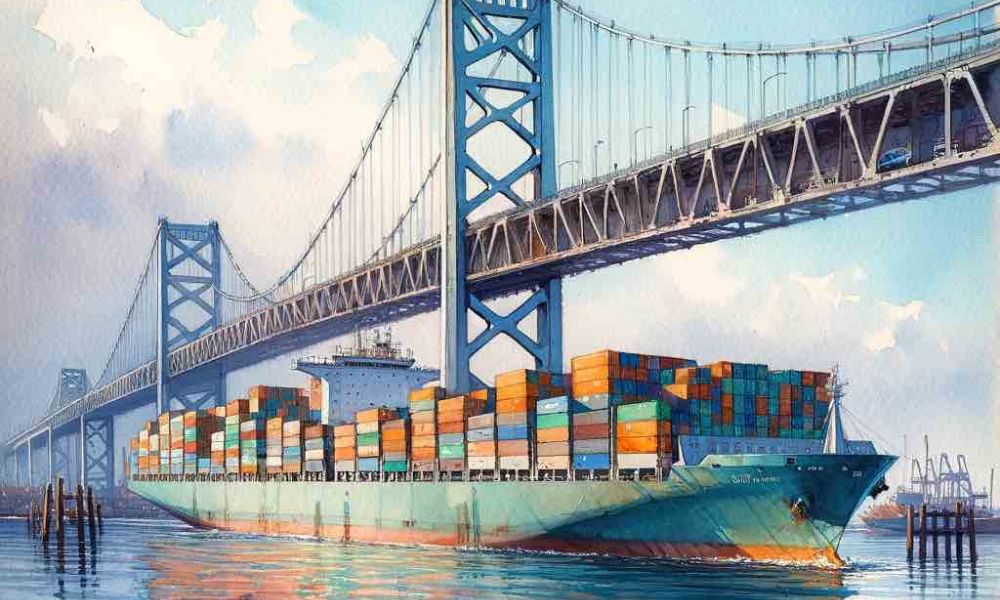
[ad_1]
Collapse expected to drive “one of the largest claims” ever for marine market
Marine
By
A search-and rescue operation is underway in Baltimore after the Francis Scott Key Bridge collapsed, sending at least seven cars into the Patapsco River. The event is likely to lead to legal wrangling and major claims activity, with reinsurers set to take a heavy hit.
The collapse is expected to drive “one of the largest claims ever to hit the marine (re)insurance market,” John Miklus, American Institute of Marine Underwriters (AIMU) told IBA.
“You’ve got various components to the loss,” Miklus said. “A big one is going to be rebuilding the bridge and all the loss of revenue and loss of tolls while that’s taking place.”
It’s expected to be a huge and costly salvage operation, Miklus said. Liability claims are also anticipated from loss of life. Six people remain unaccounted for, with rescue operations underway. There are also supply chain implications.
Could Baltimore bridge disaster top Costa Concordia cost?
Commentators have likened the scale of the incident to the sinking of the Costa Concordia. The cruise ship ran aground off the coast of Italy in 2012. The event, in which 32 people died, drove a marine insurance loss of $1.5 billion.
“I wouldn’t be surprised if this were similar,” Miklus said of the Baltimore bridge incident loss figure.
The Costa Concordia disaster (2012)
- Location: Off the coast of Isola del Giglio, Italy
- Cost: The salvage operation alone cost over $2 billion, making it one of the most expensive shipwrecks in history. Additional costs included compensation to passengers and crew, legal liabilities, and loss of the ship.
- The insured loss cost of the disaster exceeded $1 billion, making it to the most expensive marine loss of all time.
“We are horrified by what has happened in Baltimore”
The bridge collapsed Tuesday at about 1:30 a.m. local time after a container ship crashed into a support column, according to a report by The Baltimore Sun. Local authorities are calling the collapse a “mass-casualty event.”
Denmark-headquartered Maersk, the world’s second-largest shipping company, confirmed that it had chartered the vessel that hit the bridge, the container ship Dali. The Singapore-flagged vessel was operated by charter company Synergy Marine Group, according to a Financial Times report. Synergy said the owners of the Dali, Grace Ocean Pty Ltd, were cooperating with federal and state authorities.
“We are horrified by what has happened in Baltimore, and our thoughts are with all of those affected,” Maersk said in a statement. The shipping giant said no Maersk crew or personnel were onboard the Dali at the time of the incident.
The Dali had liability insurance through Britannia, part of the International Group of P&I Clubs. Together, the group has upwards of $3 billion of reinsurance cover, sources said. AXA XL is said to lead the first layer of cover for IGP&I’s reinsurance program, with other global reinsurers also in the frame.
The event is likely to add to “increasing challenges in reinsurance availability”, said AM senior director, analytics Matilde Jakobsen.
Britannia told the Financial Times that it was “working closely with the ship manager and relevant authorities to establish the facts and to help ensure that this situation is dealt with quickly and professionally.”
Chubb is the lead market for property placement on the Francis Scott Key Bridge, according to a report by Insurance Insider.
A rescue operation is underway in Baltimore after a the Francis Scott Key bridge was struck by a ship and collapsed, causing a number of vehicles to plunge into the river.https://t.co/McXdaEgifz pic.twitter.com/cghIdjv2uK
— philip lewis (@Phil_Lewis_) March 26, 2024
“Huge insurance implications”
The collapse will have a severe impact on the port of Baltimore, through which more than a million shipping containers pass every year. The port is closed to all maritime traffic until further notice, local officials have said.
Richard Meade, editor of Lloyd’s List, told Sky News that the accident and its aftermath will have “huge insurance implications” as shipping companies and maritime authorities scramble to divert trade to other ports.
“There are going to be implications in terms of what the eastern seaboard of the US now does to rearrange its logistics in order to account for this, because this is not going to be resolved in a quick manner.”
Rebuilding the bridge will cost at least 10 times its original price tag of $60 million – largely because it will need to be rebuilt quickly, according to David MacKenzie, chair of engineering and architecture consultancy COWIfonden.
“It’s got to be built quickly because you’ve heard of the pressure on the commuter traffic,” he told Sky News. “So that means it’s going to be a lot more expensive and the process of procurement is going to have to be short-cut hugely.”
The costliest US marine disasters
Deepwater Horizon Oil Spill (2010)
- Economic Cost: Over $65 billion. The Deepwater Horizon oil spill in the Gulf of Mexico is one of the most devastating environmental disasters in U.S. history. BP, the oil company responsible, spent billions on cleanup, environmental restoration, fines, and compensation for economic losses. Lloyd’s of London, Partner Re and Hannover Re all had exposure, while BP had some insurance cover through its captive.
Exxon Valdez Oil Spill (1989)
- Economic cost: Estimated total costs including cleanup, fines, and settlements of the Exxon Valdez Oil Spill were around $7 billion. The Exxon Valdez oil spill in Prince William Sound, Alaska, led to long-term environmental damage. The International Tanker Indemnity Association reportedly paid out $400 million following the spill, with Exxon also having filed claims under coverage with a $600 million limit.
Cosco Busan Oil Spill (2007)
- Economic cost: Over $100 million. The container ship Cosco Busan struck the San Francisco-Oakland Bay Bridge, spilling approximately 53,000 gallons of fuel oil into San Francisco Bay. The costs included cleanup efforts, environmental restoration, and compensation for impacted businesses and communities.
American Trader Oil Spill (1990)
- Economic cost: Estimated cleanup and compensation costs were over $50 million. The tanker American Trader spilled nearly 417,000 gallons of crude oil off the coast of Huntington Beach, California, affecting marine life and local beaches.
Search-and rescue operations ongoing
While search-and-rescue operations were ongoing, there were no confirmed fatalities as of press time, according to The Baltimore Sun. At least two people have been saved from the water so far, according to an Al Jazeera report.
Have something to say about this story? Let us know in the comments below.
Related Stories
Keep up with the latest news and events
Join our mailing list, it’s free!

[ad_2]
Source link


